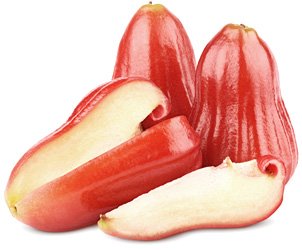Chompoo is a rose apple or Malabar plum. The fruit is pear-shaped, pitted with a pink skin and dense white flesh, similar in texture and appearance to an apple. When chilled, its pulp is an excellent thirst quencher. There are also white, green and red colors, usually the lighter, the sweeter. The season is from April to June.

- Chompoo is considered one of the favorite fruits of children. It does not need to be cleaned, it has no pits.
- Chompoo is a tree of the myrtle family, native to eastern India. It has long been grown in Sri Lanka, Indochina, and the Pacific islands.
- In 1762 it was introduced to Jamaica and spread to the Antilles, Bahamas, Bermuda, and the plains of Central and South America; from southern Mexico to Peru.
- Since the end of the nineteenth century, it has been cultivated in tropical Africa, on the Pembe Islands, Zanzibar, Reunion, and Australia.
- Although the fruit is called apple, it does not in any way resemble the fruit we know, neither in shape nor in taste.
- Chompoo is widely used in traditional medicine in those countries where it grows.
- The juice from the leaves of the Malay tree serves as a facial lotion. Fruit pulp and seeds, leaves, bark have antimicrobial action; they are also used to regulate blood pressure and treat colds.
- They taste like sweetened water, and sometimes just water, odorless and tasteless. When chilled, it is an excellent thirst quencher.
- The fruits of the Pink Apple are eaten fresh, stewed with sugar. They are used to make jams, jellies, syrups, and sauces.
- At home, their halves are often filled with a mixture of rice and meat, poured over with tomato sauce, seasoned with chopped garlic, and baked for about 20 minutes.
- They are also canned in combination with other fruits. The essential oil is extracted from the leaves. The bark of the tree is rich in tannin.
- Exotic chompoo has no contraindications; everyone can use it. Of course, it is worth remembering the possibility of individual intolerance and the fact that it is necessary to consume the fruit in reasonable quantities.
